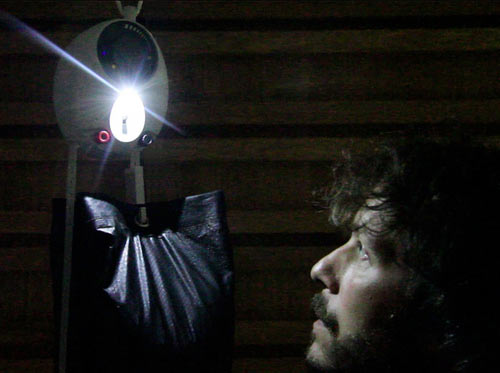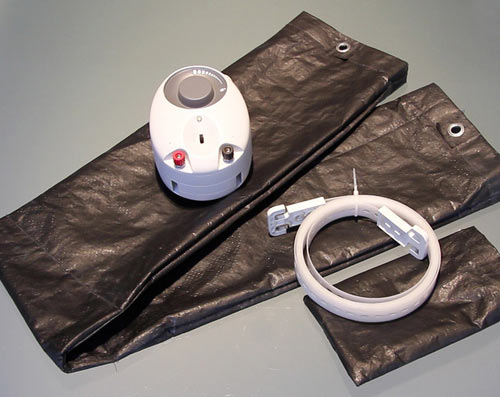A reader writes:
This gravity powered light has been getting a little attention lately. It reminded me of your post on the Gravia light.
So is the GravityLight a sensible design that conforms to the laws of physics, or is it also powered by Pixie Dust?
Lee
There's nothing inherently wrong with the basic idea of converting the energy of a falling mass into electricity. (That's how hydoelectric power stations work, after all.) It may even be possible to do it quite efficiently, and cheaply, on a small scale now.
In the olden days you would have needed to gear up your dynamo a lot from the pulley your falling weight (or flow of stream water) was turning, but today super-powerful magnets are very cheap and so efficient lower-speed dynamos are easier to make. Especially if you're only trying to light one high-intensity LED to a brightness that'll let someone read a book at close range.
The GravityLight people claim thirty minutes of light per lift of the weight, and the tape connecting the weight to the light looks to be, being generous, about 1.5 metres long. They don't say exactly what the weight is, but they do say you can fill the GravityLight weight bag...
...with use "anything weighing about 20lbs"; let's again be generous and say you get ten kilos of stuff in there, which is a perfectly liftable weight for a wide range of humans.
So we've got ten kilograms falling 1.5 metres in standard gravitation; that gives us a maximum of 147 joules to play with.
Split over thirty minutes, which is 1800 seconds, that gives us only 0.082 joules per second. That means a power of 0.082 watts, or 82 milliwatts.
A single standard white LED will have spec-sheet power numbers of about 20 milliamps at 3.6 volts, which is 72 milliwatts. It'll work fine - and more efficiently - at rather lower current, though, which is just as well because this falling-weight system is certain to be a long way short of 100% efficient at turning the weight's gravitational potential energy into light.
Even if it's only 50% efficient, though, you've still got 36 milliwatts to play with, which is plenty to light one LED to a useful, though far from room-filling, brightness. Even if you pare off some of the above generous assumptions about weight and fall distance, you'll still be easily above 20 milliwatts, which is also usefully bright.
The GravityLight people say their invention is intended to replace kerosene lanterns, but it's definitely not going to have the room-filling brightness of a kerosene lamp with the wick turned well up. Given the numerous downsides of kerosene lighting, though, and the fact that a lot of poor people probably don't turn their lamps up to max very often, a GravityLight or two could well replace one.
The ridiculous Gravia concept thing had a heavier weight falling a similar distance, for a total of about 271 joules. But the designer idiotically claimed that the thing would have the light output of a forty-watt incandescent bulb for four hours. This was so impossible that it couldn't come anywhere near being done even in Physics Experiment Land, with a perfectly efficient dynamo and a perfectly efficient lamp.
With real-world hardware, in contrast, the GravityLight can work. I'm not totally convinced that for household lighting you wouldn't be better off with a couple of conductive objects a reasonable distance from each other in the galvanic series, some damp earth as an eletrolyte, and a Joule Thief to boost the output to run an LED. That sort of improvised battery can run for a very long time at the very low power a Joule-Thiefed LED requires, and its poor portability doesn't matter if you're using it as a hoursehold light (and is an advantage if you want to avoid your light being stolen...).
But the physics, at least, checks out for the GravityLight.


12 December 2012 at 2:51 pm
Had a look at the video and I think the 30 minute run time was with the lamp turned down, so the 20 milliwatts, give or take, would be the minimum. Good for use as a night light or something to that effect.
By the looks of it in the video, at full brightness the weight was descending quite quickly, so a run time of just under 10 minutes at almost full brightness would be more realistic.
12 December 2012 at 6:26 pm
I notice that there are hooks on both ends of the strap material. I am assuming the hook snaps off because it would be silly to disassemble the gadget to thread the strap.
I am thinking that you could easily scale it up by hanging it from a tree or the ridge of the roof and using a longer strap, possibly also a heavier weight. Assuming a one-way roller device you would only need a rope to pull the weight back up to the top. Say 1.5 times the weight for a brighter light and twice the distance for a light that lasted a full hour and it would be worth hauling on the rope for a few seconds.
This is a neat device, and I would love to see them on shelves where I live.
13 December 2012 at 1:36 pm
I was going to say exactly this. The concept is sensible, but it needs to be scaled up.
1) It must be able to use whatever cable is available, so you can hang it on the roof of a two-story house or something and use anything that's available to tie your weight to.
2) It must be rechargeable by simply pulling on the other end of the rope, so you don't need to haul a large weight up a ladder
3) It must have a variable output setting, so you can vary power, weight and height according to the situation.
Given a decent height (house, tree, what have you), and assuming a human of average construction who wouldn't have to sweat too much to lift, say, a 20kg weight ten metres or so, this would actually give a useful amount of power. Add more humans - as would probably be the case most of the time - and you could multiply the weight by their number, and thus the energy obtained. Add a geared crank system to let even one human lift, say, 50kg (possibly pedal-powered, as the muscles in our legs are the most powerful we have) and you effectively have a battery without many of the problems of chemical energy storage.
I'm now pondering the possibility of using a geared electric motor to lift a comparatively huge weight, hooking that up to a generator and a solenoid, and using it to power a PSU for the computer. Lead-acid? Who needs lead-acid?
13 December 2012 at 12:43 am
The question now is how much can this implementation be abused and/or improved upon by the geek army.
22 December 2012 at 5:04 pm
The effort of lifting 10kg's 1.5m anecdotally seems substantially less than turning a heavy crank for 30 seconds... Fooling around with weight bags and finding somewhere high enough to hang it seems a bit unnecessary when you should be able to get more charge into a capacitor if you have similarly powerful magnets and a sufficiently large crank.
22 December 2012 at 8:42 pm
I think the idea with the dangling-weight doodads is that they don't have to contain ANY energy-storage device - battery, capacitor, whatever. By generating a trickle of power constantly, you get better efficiency than you could if you were storing it.
17 January 2013 at 2:23 am
arstechnica found it:
http://arstechnica.com/science/2013/01/kerosene-lamps-face-gravity-powered-usurper/
--Me